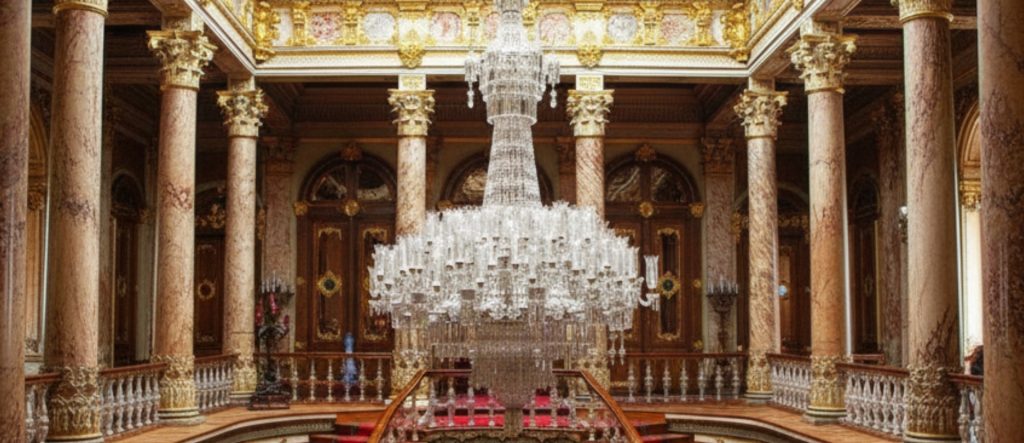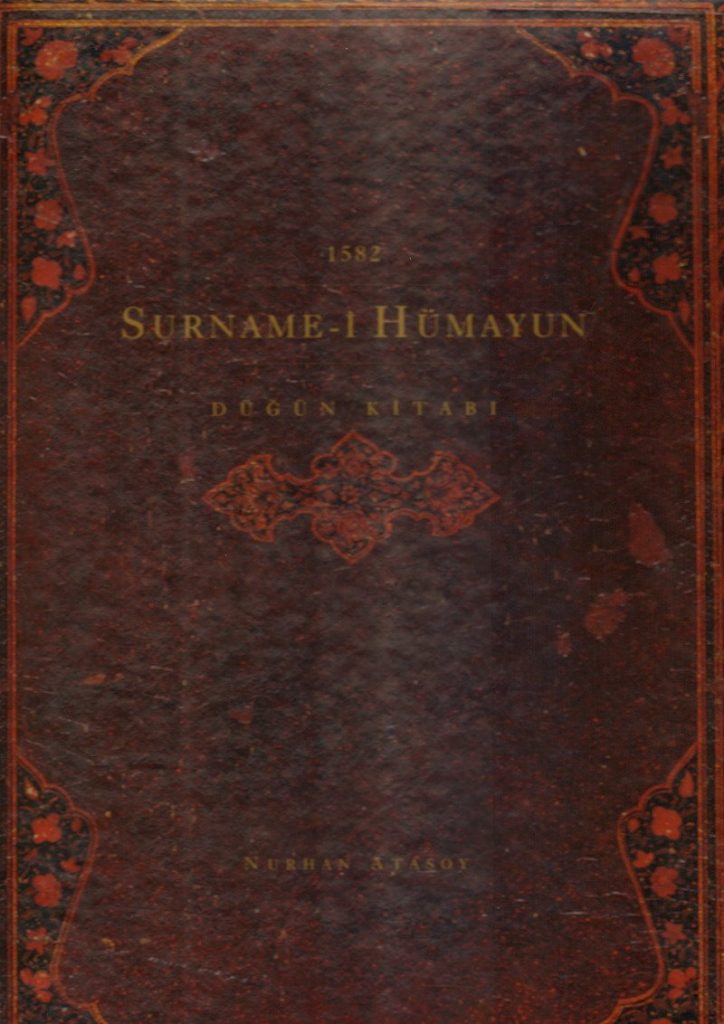The Palace Collections
Dolmabahçe’s collection is not an ancient treasury, but a curated reflection of 19th-century imperial taste and diplomatic exchange.
It tells the story of an empire engaging with the world, commissioning art from European masters while perfecting its own unique crafts. Here, you will discover a priceless legacy of painting, porcelain, carpets, and crystal.
The Crystal Dialogue
The chandeliers of Dolmabahçe are not mere decorations; they are a silent dialogue of power and prestige.
From the world’s largest Bohemian masterpiece in the Ceremonial Hall to the Baccarat crystals gifted by Queen Victoria, each one is a diplomatic note, a glittering testament to the Empire’s place on the world stage.

The Crystals of Diplomacy: Dolmabahçe’s Chandelier Collection and Glittering Messages

A Festival Painted on Paper

The Sûrname-i Hümâyûn
Stories of Craftsmanship & Patronage
Explore in-depth articles on the artists, artisans, and diplomatic gifts that contributed to the palace’s magnificent collections.
Thrones, Armchairs, and Consoles: How Dolmabahçe’s Furniture Redefined Power and Comfort?
The Palace’s Porcelain: The Birth of the Yıldız Tile Factory, the Second National Brand After Hereke
An Empire Laid on the Floor: Hereke Carpets, the Birth of an Art and Industry Brand in Dolmabahçe
Enrich Your Exploration

Medicana: A Legacy of Health

Avis: The Keys to the City
The Imperial Painting Collection
From Manuscript to Canvas: An Artistic Revolution
In Topkapı Palace, art was a secret whispered in the pages of manuscripts, an intricate world of miniatures meant for the exclusive domain of the Sultan’s eye. Dolmabahçe Palace declared a revolution.
Here, art was no longer a private treasure, but a public statement of power and modernity, proclaimed from vast oil paintings on its grand walls. This was more than a change in medium; it was a fundamental shift in imperial identity. In this new era, the Sultan was not just a conqueror to be chronicled, but a sophisticated international patron of the arts, and his palace was his gallery.
The Court's Favorite: Ivan Aivazovsky, Master of the Seas
No artist captured the soul of 19th-century Istanbul like the Russian master, Ivan Aivazovsky. He became the court’s favorite, forging a unique bond with both Sultan Abdülmecid and Sultan Abdülaziz. His brush could command the fury of a storm-tossed sea or the serene tranquility of a moonlit Bosphorus with equal genius.
Invited to the capital multiple times, he produced over thirty masterpieces specifically for the palace collection. These were more than mere landscapes; they were reflections of an empire’s romantic soul and its enduring maritime power, seen through the eyes of a foreign genius who had fallen in love with the city.
From Manuscript to Canvas: An Artistic Revolution
The Sultan’s patronage was also a catalyst for a native artistic renaissance. While foreign masters were celebrated, the palace actively nurtured a new generation of Western-trained Ottoman masters, such as the soldier-painter Şeker Ahmed Pasha and the legendary intellectual Osman Hamdi Bey.
They were sent to Paris to study, returning to create a uniquely Ottoman interpretation of academic painting. The tradition culminated in the figure of Caliph Abdülmecid Efendi, the last heir to the throne, who was himself a distinguished painter. Their works, hanging alongside their European counterparts, tell the story of a culture confidently finding its own modern artistic voice.
Where the Palace Meets the Palate
Lacivert: The Bosphorus, Reimagined for Your Palate
You’ve witnessed the imperial grandeur from within the palace walls.
Now, experience its reflection across the water. At Lacivert, the timeless silhouette of Istanbul meets the vibrant flavors of the Mediterranean, creating a memory worthy of the view.
The Art of the Loom
An Industry Born of Imperial Necessity
In Topkapı Palace, art was a secret whispered in the pages of manuscripts, an intricate world of miniatures meant for the exclusive domain of the Sultan’s eye. Dolmabahçe Palace declared a revolution.
Here, art was no longer a private treasure, but a public statement of power and modernity, proclaimed from vast oil paintings on its grand walls. This was more than a change in medium; it was a fundamental shift in imperial identity. In this new era, the Sultan was not just a conqueror to be chronicled, but a sophisticated international patron of the arts, and his palace was his gallery.
A Dialogue Woven in Silk
No artist captured the soul of 19th-century Istanbul like the Russian master, Ivan Aivazovsky. He became the court’s favorite, forging a unique bond with both Sultan Abdülmecid and Sultan Abdülaziz. His brush could command the fury of a storm-tossed sea or the serene tranquility of a moonlit Bosphorus with equal genius.
Invited to the capital multiple times, he produced over thirty masterpieces specifically for the palace collection. These were more than mere landscapes; they were reflections of an empire’s romantic soul and its enduring maritime power, seen through the eyes of a foreign genius who had fallen in love with the city.
The Fabric of Diplomacy
The Sultan’s patronage was also a catalyst for a native artistic renaissance. While foreign masters were celebrated, the palace actively nurtured a new generation of Western-trained Ottoman masters, such as the soldier-painter Şeker Ahmed Pasha and the legendary intellectual Osman Hamdi Bey.
They were sent to Paris to study, returning to create a uniquely Ottoman interpretation of academic painting. The tradition culminated in the figure of Caliph Abdülmecid Efendi, the last heir to the throne, who was himself a distinguished painter. Their works, hanging alongside their European counterparts, tell the story of a culture confidently finding its own modern artistic voice.

Masters of Crystal & Porcelain
The Luster of the West: A Passion for the Priceless
To decorate Dolmabahçe was to speak the international language of 19th-century luxury, and the Sultanate was determined to be fluent. The palace reveals an imperial passion for Europe’s most coveted brands.
From France came the dazzling works of Baccarat, whose solid crystal forms the very balustrade of the main staircase, and the monumental vases of Sèvres, often arriving as direct gifts from heads of state. These were not mere decorations; they were trophies of a new era, symbols of modernity and the empire’s ability to command the absolute finest that the Western world had to offer.
An Imperial Answer: The Birth of Yıldız Porcelain
But the empire was not content to be merely a consumer. In a strategic move to create a national luxury brand, Sultan Abdülhamid II established the Yıldız Çini Fabrika-i Hümayunu (Yıldız Imperial Porcelain Factory). The goal was ambitious: to produce porcelain of European quality, but with a distinctly Ottoman soul.
The masters at Yıldız blended Western forms with traditional Turkish motifs, from delicate floral patterns to elegant calligraphy, often using a unique turquoise hue that became their signature. This was an imperial answer to the West, a declaration of cultural self-confidence.
A Dialogue in the Salons: East and West in Harmony
To walk through the halls of Dolmabahçe is to witness a silent, elegant dialogue. Here, a monumental Sèvres vase gifted by a French Emperor stands in a salon just rooms away from a delicate Yıldız porcelain piece bearing the Sultan’s Tughra. This was not a contradiction; it was the very essence of the late Ottoman identity.
The collection tells the story of an empire simultaneously open to the world and deeply proud of its own heritage, creating a unique synthesis of styles that is the true, priceless treasure of Dolmabahçe Palace.
The Gilded Furniture
The Revolution of Sitting: From Divan to Chair
The furniture of a palace defines its power structure. In Topkapı, power was communal, experienced from low divans and floor cushions, fostering a sense of shared space. Dolmabahçe sparked a revolution by embracing the verticality of the European chair.
This was not merely a stylistic choice; it was a philosophical shift towards individual status, face-to-face diplomacy, and a new social hierarchy. To sit on a chair in Dolmabahçe was to speak the new, formal language of the Western courts, a language of protocol that reshaped the very nature of imperial life.
An Echo in Gilded Wood and Silk
The salons of Dolmabahçe echo with the grand styles of 19th-century Europe. The dominant influences of French Louis XV and Louis XVI, alongside English Victorian touches, are visible in every piece.
The intricate, gilded wood carvings, the opulent silk and velvet upholstery, and the graceful, curved lines of the furniture create a seamless symphony with the palace’s overall Baroque and Rococo aesthetic. This was a conscious effort to create a setting that was not just Ottoman, but undeniably world-class, a stage fit for receiving the most powerful monarchs of the age.
A Signature Carved in Wood
Yet, the furniture of Dolmabahçe is not a simple imitation; it is a confident reinterpretation. While many pieces were inspired by European designs, a significant portion was crafted in the palace’s own Imperial Carpentry workshops (Marangozhane-i Hümayun).
Here, Ottoman masters took Western forms and imbued them with a subtle local soul, sometimes incorporating traditional motifs or adapting designs to suit specific courtly functions. This synthesis of styles tells the true story of Dolmabahçe: not of a culture surrendering its identity, but of one confidently adapting and shaping global trends to create a new imperial aesthetic.







